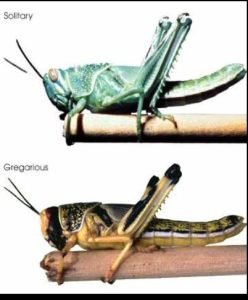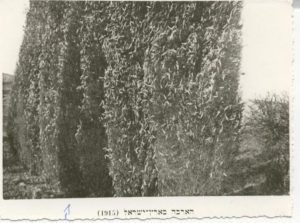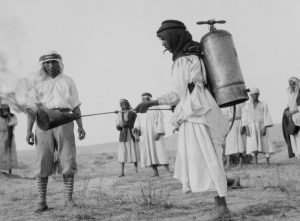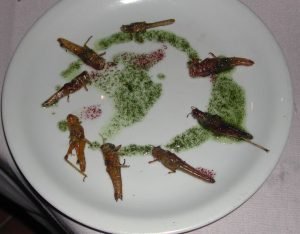What if a plague destroyed a whole year’s worth of work in your garden? What if it destroyed not only all the food you grew but all the food in the region? This is the situation described in our Mishnah:
“MISHNA: one who receives a field from another and grasshoppers consumed it or it was wind blasted, if it is a regional disaster, the cultivator subtracts from the produce he owes as part of his tenancy.” (Bava Metzia 105b)
Locusts are one of the most destructive creatures known to man. They appear in Tanakh in a few situations, usually to disastrous effect. One of the terrible plagues that afflict the Egyptians when they refuse to release their Israelite slaves is arbeh, locusts:
“For if you refuse to let My people go, tomorrow I will bring locusts on your territory. They shall cover the surface of the land, so that no one will be able to see the land. They shall devour the surviving remnant that was left to you after the hail; and they shall eat away all your trees that grow in the field.” (Shmot 10:4-5)
An echo of this depredation is described by the prophet Yoel many hundreds of years later. He compares a locust plague to an attack by an invading army or by lions:
“For a nation has invaded my land, vast beyond counting, with teeth like the teeth of a lion, with the fangs of a lion’s breed.” (Yoel 1:6)
There are those who suggest that the metaphor should be flipped; that what the prophet really is describing is an invasion by a foreign army, who are compared to the ravenous locusts. Either way the invading hordes strip the fields of any sustenance:
“They have laid my vines waste and splintered my fig trees: they have stripped off their bark and thrown [it] away; their runners have turned white.” (Yoel 1:7)
Why is a locust, a creature about the size of a paper clip, compared to the most ferocious men and beasts? Locusts are curious insects. They can exist on their own and then they are no more dangerous than a grasshopper, eating a little vegetation here and there. But they can also become what is called “gregarious.” They change color and behavior and join together with billions of other locusts to form massive swarms. A locust swarm can cover twelve hundred square kilometers and each square kilometer can contain between forty to eighty million insects. Each locust can eat its own weight in plants each day. In total a locust swarm can eat one hundred and ninety-two million kilograms of plants per day! Add to these insane numbers the fact that swarms can travel thousands of kilometers – in 1988 a swarm traveled from West Africa to the Caribbean – and you can see why locusts are more terrifying than an invading army.

Compton Tucker, NASA GSFC, Public domain, via Wikimedia Commons
The prophet Yoel uses a number of terms to describe locusts:
יֶ֤תֶר הַגָּזָם֙ אָכַ֣ל הָאַרְבֶּ֔ה וְיֶ֥תֶר הָאַרְבֶּ֖ה אָכַ֣ל הַיָּ֑לֶק וְיֶ֣תֶר הַיֶּ֔לֶק אָכַ֖ל הֶחָסִֽיל׃
“What the cutter has left, the locust has devoured;
What the locust has left, the grub has devoured;
And what the grub has left, the hopper has devoured.” (Yoel 1:4)
and there are actually ten different names for locusts in Tanakh. Professor Yehuda Feliks explains the terms in Yoel as referring to different stages of the insect’s growth. The yelek is the larvae, that has no wings yet. It licks the plants, hence its name which has the same root as licking, מלקק. After it grows and sheds its skin it becomes a chasil. This is the young locust who destroys, מחסל, the plants. It sheds its skin a second time and changes into a gezem, that eats the bark, גזם, from the trees. Finally the locust transforms into an arbeh, the mature insect that no longer eats but lays eggs that will continue the destructive cycle.
Other commentators disagree and see the four names as representing four sub-species of locusts (there are a few dozen species of locusts). Still others believe that the four names simply refer to four separate swarms arriving from four directions.
The arbeh, or desert locust, attacks in Africa, Asia and the Middle East. In the Land of Israel we have evidence of many locust swarms after Biblical times. One of the most recent terrible ones was in 1915. This was a particularly devastating event as it happened during World War I when the population here was already coping with famine, disease and war. A description by an eyewitness gives an idea of how farmers tried to fight back against the swarm:
“From far away, from the farm and from the vineyards, arise sounds of banging. . . the growers have gone to battle. . .but what are hundreds of hands of farmers against thousands upon thousands of billions of them, as many as the sand on the beach. . .” (Moses Smilanski, Rehovot 1915)

Locusts in the Rehovot fields 1915
ארכיון לתולדות רחובות,אוסף קפרא, CC BY 2.5 <https://creativecommons.org/licenses/by/2.5>, via Wikimedia Commons
The locusts ate whatever crops had not been stolen by the ravenous Turkish army. The renowned agronomist Aaron Aaronsohn was called in to try and find a solution but he was defeated by the insects as well. The Turks resorted to forcing every teenager and adult to collect twenty kilograms of locusts.

One attempt to get rid of locusts: smoking them out
American Colony, Jerusalem, Public domain, via Wikimedia Commons
What do you do if the locusts eat all your food? Maybe you should eat the locusts. This brings us to the interesting question of whether locusts are kosher. The Torah seems to indicate that at least some are:
“But these you may eat among all the winged swarming things that walk on fours: all that have, above their feet, jointed legs to leap with on the ground—of these you may eat the following: locusts of every variety; all varieties of bald locust; crickets of every variety; and all varieties of grasshopper.” (Vayikra 11:21-22)
The Mishnah in Hullin adds more details and lists signs to help us to identify which locust species are allowed to be eaten:
“And with regard to grasshoppers,: Any that has four legs, and four wings, and [two additional] jumping legs, and whose wings cover most of its body, [is kosher]. Rabbi Yosei says: And the name of its species is grasshopper חגב.” (Mishnah Hullin 3:7)
Some Jewish communities kept alive the tradition of eating locusts while others forgot the signs of their kashrut. Not surprisingly, the places where locusts swarmed: Yemen, North Africa – were also the communities that continued to eat (kosher) locusts. In Europe on the other hand, there were no locust swarms and so Rashi and other scholars were not familiar with which locusts were kosher.
Today, with the ingathering of the exiles, some rabbis and scholars are trying to collect the almost forgotten traditions about kashrut and even to revive the eating of creatures that are kosher, if off the beaten track. Dr. Ari Zivotofsky and Dr. Ari Greenspan are among those who have spoken to Yemenite elders and scholars and have identified the kosher locust species. Rabbi Natan Slifkin in his Biblical Museum of Natural History actually sells kosher locusts to eat. They are an excellent source of protein and are thought to be the food of the future (no I have not tried them).

Locusts tastefully plated at the Mesorah Dinner
Photo courtesy of Dr. Ari Zivotofsky
For more about the kashrut of locusts see this article: https://www.biblicalnaturalhistory.org/post/kosher-locust










